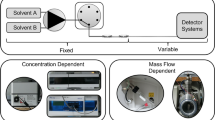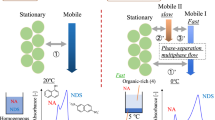Abstract
To reduce solvent consumption and cycle times of analyses, the inner diameters (ID) of separation columns are being reduced continuously. In particular, 1.0 mm inner diameter columns seem to be the next logical step, as they represent a good compromise between sample loading and analysis speed. However, the necessary optimization of the extra-column volume is often not considered. The aim of this study was therefore to investigate the influence of the column inner diameter on the efficiency in the isocratic and gradient elution mode. The efficiency of 0.3, 0.5, 1.0, and 2.1 mm inner diameter columns were compared using a µ-HPLC and UHPLC system. To enable a fair comparison between the different columns, the linear flow velocity was kept constant. In isocratic mode, the influence of the extra-column volume dispersion was assessed by the peak standard deviation and the reduced plate height. In gradient mode, the separation of 7 antineoplastic drugs was compared in terms of the peak capacity and chromatographic resolution. Amongst other things, it was shown that the ratio between extra-column volume and effective-column volume can be a simple parameter for choosing an appropriate column ID /HPLC combination. An unfavorable ratio between extra-column volume and effective-column volume led to a doubling of the minimum plate height.




Similar content being viewed by others
Data availability
Data is available from the authors upon request.
References
Jorgenson JW, Guthrie EJ (1983) Liquid chromatography in open-tubular columns. Theory of column optimization with limited pressure and analysis time, and fabrication of chemically bonded reversed-phase columns on etched borosilicate glass capillaries. J Chromatogr A 255:335–348. https://doi.org/10.1016/S0021-9673(01)88293-5
Novotny MV (2017) Development of capillary liquid chromatography: a personal perspective. J Chromatogr A 1523:3–16. https://doi.org/10.1016/j.chroma.2017.06.042
Xiang P, Yang Y, Zhao Z, Chen M, Liu S (2019) Ultrafast gradient separation with narrow open tubular liquid chromatography. Anal Chem 91:10738–10743. https://doi.org/10.1021/acs.analchem.9b02190
Thoben C, Werres T, Henning I, Simon PR, Zimmermann S, Schmidt TC, Teutenberg T (2022) Towards a miniaturized on-site nano-high performance liquid chromatography electrospray ionization ion mobility spectrometer with online enrichment. Green Anal Chem 1:100011. https://doi.org/10.1016/j.greeac.2022.100011
Napolitano-Tabares PI, Negrín-Santamaría I, Gutiérrez-Serpa A, Pino V (2021) Recent efforts to increase greenness in chromatography. Curr Opin Green Sustain Chem 32:100536. https://doi.org/10.1016/j.cogsc.2021.100536
Gałuszka A, Migaszewski Z, Namieśnik J (2013) The 12 principles of green analytical chemistry and the SIGNIFICANCE mnemonic of green analytical practices. TrAC Trends Anal Chem 50:78–84. https://doi.org/10.1016/j.trac.2013.04.010
Gritti F, Wahab MF (2018) Understanding the science behind packing high-efficiency columns and capillaries: facts fundamentals, challenges, and future directions. LCGC North Am 36:82–98
Werres T, Schmidt TC, Teutenberg T (2021) The influence of injection volume on efficiency of microbore liquid chromatography columns for gradient and isocratic elution. J Chromatogr A 1641:461965. https://doi.org/10.1016/j.chroma.2021.461965
Wang H, Bennett P (2013) Performance assessment of microflow LC combined with high-resolution MS in bioanalysis. Bioanalysis 5:1249–1267. https://doi.org/10.4155/bio.13.93
Heemskerk AAM, Busnel JM, Schoenmaker B, Derks RJE, Klychnikov O, Hensbergen PJ, Deelder AM, Mayboroda OA (2012) Ultra-low flow electrospray ionization-mass spectrometry for improved ionization efficiency in phosphoproteomics. Anal Chem 84:4552–4559. https://doi.org/10.1021/ac300641x
Mejía-Carmona K, da Soares Silva Burato J, Borsatto JVB, de Toffoli AL, Lanças FM (2020) Miniaturization of liquid chromatography coupled to mass spectrometry: 1 Current trends on miniaturized LC columns. TrAC Trends Anal Chem 122:115735. https://doi.org/10.1016/j.trac.2019.115735
Dams M, Dores-Sousa JL, Lamers RJ, Treumann A, Eeltink S (2019) High-resolution nano-liquid chromatography with tandem mass spectrometric detection for the bottom-up analysis of complex proteomic samples. Chromatographia 82:101–110. https://doi.org/10.1007/s10337-018-3647-5
Rahimi F, Chatzimichail S, Saifuddin A, Surman AJ, Taylor-Robinson SD, Salehi-Reyhani A (2020) A Review of portable high-performance liquid chromatography: the future of the field? Springer, Berlin. https://doi.org/10.1007/s10337-020-03944-6
Patel DC, Wahab MF, O’Haver TC, Armstrong DW (2018) Separations at the speed of sensors. Anal Chem 90:3349–3356. https://doi.org/10.1021/acs.analchem.7b04944
Halász I, Endele R, Asshauer J (1975) Ultimate limits in high-pressure liquid chromatography. J Chromatogr A 112:37–60. https://doi.org/10.1016/S0021-9673(00)99941-2
Fekete S, Murisier A, Losacco GL, Lawhorn J, Godinho JM, Ritchie H, Boyes BE, Guillarme D (2021) Using 1.5 mm internal diameter columns for optimal compatibility with current liquid chromatographic systems. J Chromatogr A 1650:462258. https://doi.org/10.1016/j.chroma.2021.462258
Libert BP, Godinho JM, Foster SW, Grinias JP, Boyes BE (2022) Implementing 1.5 mm internal diameter columns into analytical workflows. J Chromatogr A 1676:463207. https://doi.org/10.1016/j.chroma.2022.463207
Lestremau F, Wu D, Szücs R (2010) Evaluation of 1.0mm i.d. column performances on ultra high pressure liquid chromatography instrumentation. J Chromatogr A 1217:4925–4933. https://doi.org/10.1016/j.chroma.2010.05.044
Broeckhoven K, Desmet G (2020) Advances and challenges in extremely high-pressure liquid chromatography in current and future analytical scale column formats. Anal Chem 92:554–560. https://doi.org/10.1021/acs.analchem.9b04278
Desmet G, Broeckhoven K (2019) Extra-column band broadening effects in contemporary liquid chromatography: causes and solutions. TrAC Trends Anal Chem 119:115619. https://doi.org/10.1016/j.trac.2019.115619
Vanderlinden K, Broeckhoven K, Vanderheyden Y, Desmet G (2016) Effect of pre- and post-column band broadening on the performance of high-speed chromatography columns under isocratic and gradient conditions. J Chromatogr A 1442:73–82. https://doi.org/10.1016/j.chroma.2016.03.016
Stankovich JJ, Gritti F, Stevenson PG, Guiochon G (2013) The impact of column connection on band broadening in very high pressure liquid chromatography. J Sep Sci 36:2709–2717. https://doi.org/10.1002/jssc.201300175
Gritti F, Guiochon G (2011) On the minimization of the band-broadening contributions of a modern, very high pressure liquid chromatograph. J Chromatogr A 1218:4632–4648. https://doi.org/10.1016/J.CHROMA.2011.05.024
Werres T, Schmidt TC, Teutenberg T (2022) Peak broadening caused by using different micro–liquid chromatography detectors. Anal Bioanal Chem. https://doi.org/10.1007/s00216-022-04170-9
Spaggiari D, Fekete S, Eugster PJ, Veuthey JL, Geiser L, Rudaz S, Guillarme D (2013) Contribution of various types of liquid chromatography-mass spectrometry instruments to band broadening in fast analysis. J Chromatogr A 1310:45–55. https://doi.org/10.1016/j.chroma.2013.08.001
Hetzel T, vom Eyser C, Tuerk J, Teutenberg T, Schmidt TC (2016) Micro-liquid chromatography mass spectrometry for the analysis of antineoplastic drugs from wipe samples. Anal Bioanal Chem 408:8221–8229. https://doi.org/10.1007/s00216-016-9932-y
Reising AE, Schlabach S, Baranau V, Stoeckel D, Tallarek U (2017) Analysis of packing microstructure and wall effects in a narrow-bore ultrahigh pressure liquid chromatography column using focused ion-beam scanning electron microscopy. J Chromatogr A 1513:172–182. https://doi.org/10.1016/j.chroma.2017.07.049
Gritti F, Dion M, Felinger A, Savaria M (2018) Characterization of radial and axial heterogeneities of chromatographic columns by flow reversal. J Chromatogr A 1567:164–176. https://doi.org/10.1016/j.chroma.2018.07.011
Gritti F (2018) A stochastic view on column efficiency. J Chromatogr A 1540:55–67. https://doi.org/10.1016/j.chroma.2018.02.005
Werres T, Leonhardt J, Jäger M, Teutenberg T (2019) Critical comparison of liquid chromatography coupled to mass spectrometry and three different ion mobility spectrometry systems on their separation capability for small isomeric compounds. Chromatographia 82:251–260. https://doi.org/10.1007/s10337-018-3640-z
Gritti F, Tanaka N (2019) Slow injector-to-column sample transport to maximize resolution in liquid chromatography: theory versus practice. J Chromatogr A 1600:219–237. https://doi.org/10.1016/j.chroma.2019.04.060
Acknowledgements
We would like to thank the Federal Ministry for Economic Affairs and Climate Action for funding the INNO-KOM project 49MF210010. Furthermore, we would like to thank Dr. Daniel Eßer from YMC Europe GmbH for providing the HPLC columns.
Author information
Authors and Affiliations
Contributions
TW: Conceptualization, Investigation, Visualization, Project administration, Writing—original draft. TCS: Supervision, Writing—review and editing. TT: Funding acquisition, Supervision, Writing—review and editing.
Corresponding author
Ethics declarations
Conflict of Interest
The authors declare that they have no known competing financial interests or personal relationships that could have appeared to influence the work reported in this paper.
Additional information
Publisher's Note
Springer Nature remains neutral with regard to jurisdictional claims in published maps and institutional affiliations.
Rights and permissions
Springer Nature or its licensor (e.g. a society or other partner) holds exclusive rights to this article under a publishing agreement with the author(s) or other rightsholder(s); author self-archiving of the accepted manuscript version of this article is solely governed by the terms of such publishing agreement and applicable law.
About this article
Cite this article
Werres, T., Schmidt, T.C. & Teutenberg, T. Influence of the Column Inner Diameter on Chromatographic Efficiency in Miniaturized and Conventional Ultra-High-Performance Liquid Chromatography. Chromatographia 86, 143–151 (2023). https://doi.org/10.1007/s10337-023-04237-4
Received:
Revised:
Accepted:
Published:
Issue Date:
DOI: https://doi.org/10.1007/s10337-023-04237-4




